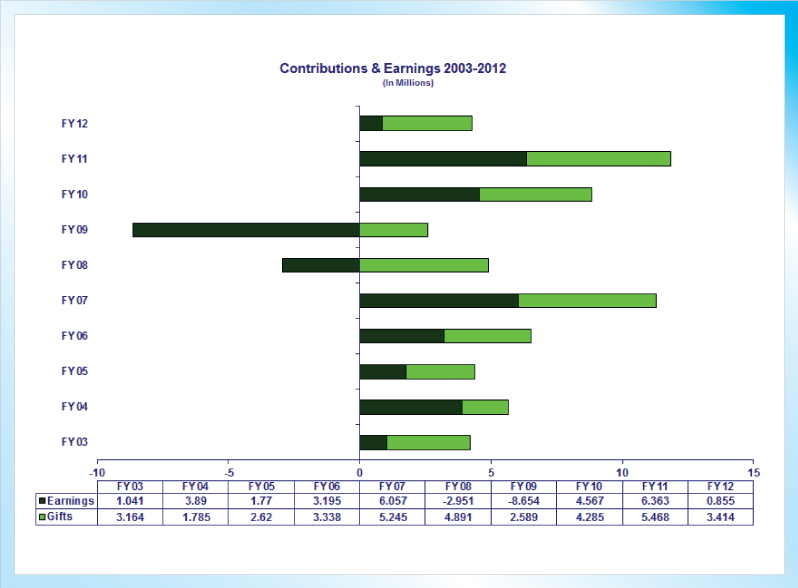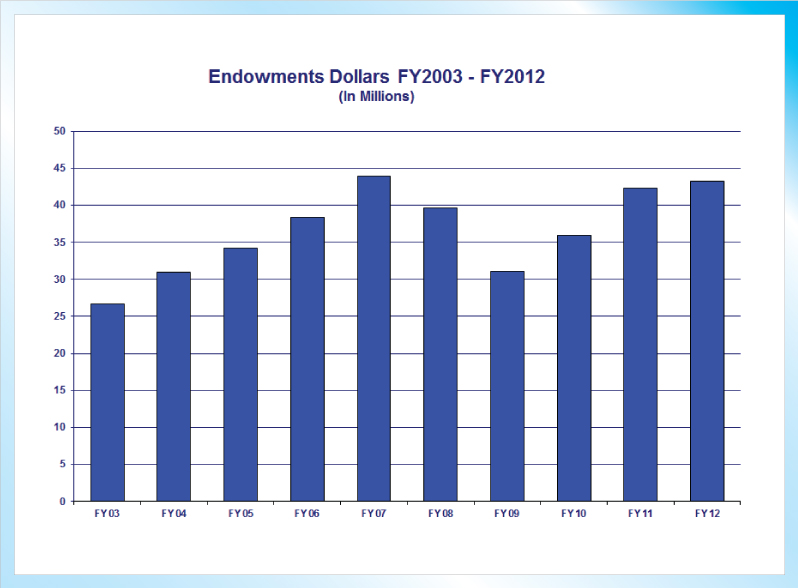Financial Report

A Report from Hazel P. Duncan, MBA, CMA
Chief Financial Officer/Secretary/Treasurer
Longwood University Foundation
Investment Performance
Gifts and bequest commitments to Longwood University Foundation were at an all-time high for the fiscal year that ended June 30, 2012. In addition, the rate of return on the endowment and other holdings was more than three times the national average.
However, returns for fiscal year 2012 were considerably lower nationally, as well as for the Foundation, than in the previous year. According to the 2012 NACUBO-Commonfund Study of Endowments, the average return for fiscal year 2012 was 0.3 percent—considerably lower than the double-digit average return rate for fiscal year 2011. The Foundation’s rate of return for FY 2012 was .94 percent.
On July 1, 2010, we moved our investment portfolio to the Richmond Fund of the Spider Management Company. The Spider Management Company’s philosophy is aligned with our own: preservation of the corpus, absolute rather than relative performance, a fully diversified portfolio and a long-term horizon.
Several financial achievements merit special attention:
- Gifts and bequest commitments totaled $9.9 million. This year’s gifts and commitments are the highest in more than 11 years. The bequest commitments are not included in the current year’s contributions, therefore they are not reflected in the contribution and earnings chart.
- Scholarship payments increased $158,000 over the previous year.
- 11 new permanently endowed funds were created.
- 585 students received scholarships.
A goal of the Foundation is to achieve investment performance that supports stable endowment spending from year to year, which provides predictable funding for programs. The Foundation Board of Directors approved a spending rate of 4 percent. The overriding principle for this rate is simple: funds should be managed so that a gift today will fund a donor’s objective in perpetuity. According to the 2012 NACUBO Commonfund study, the average annual effective spending rate for educational endowments in FY 2012 was 4.2 percent. That makes our 4 percent rate just below the national average.
In addition, the recent market crisis caused many of our endowed funds to be considered “underwater.” This means that the market values of these funds are now less than the original gift values. It was the board’s position that these funds should be allowed to grow and strengthen. On June 30, 2012, 35 of our 320 endowed funds were underwater. All underwater scholarship funds were paid using alternative funding sources from the Foundation or Longwood University so that the funds would not be further depleted and assuring that students who depended on the awards would be not be hindered from attending.
Prudent decisions such as this have enabled the Foundation to sustain the distributions to the university for scholarships as well as other programs until the endowments have grown sufficiently to handle the distributions.
Over the last nine years, since the spending rate was reduced to 4 percent, the amount paid out for scholarship awards has shown a steady increase. This chart is evidence of the strong partnership among donors, the Foundation and the university, who continue to work together for the common good of the students. Without the infusion of $450,000 from the university and help from donors who gave additional funds for awards, many of our students would have been left without the means to continue their education. I am honored to be at a university where the needs of the students continue to be so highly regarded by all constituencies.
Cherry Bekaert LLP conducted its annual independent audit and the Foundation received another unqualified audit. A copy of the annual audited financial statements can be found on the Foundation website at www.longwood.edu/foundation.html. Following this summary, I have included a more detailed report that highlights our endowment activity and the Foundation’s management policies.
Annual Report on the Pooled Investment Fund
This report has been prepared to provide information about our donor-raised funds and the management and performance of the Longwood University Foundation’s Pooled Investment Funds.
The Longwood University Foundation’s Board of Directors delegated the investment management of the Pooled Investment Funds to the Finance Committee, which operates within the parameters of the Investment Policy.
The Finance Committee seeks investment returns through a diversified investment portfolio consistent with the approved Investment Policy. To achieve its investment objective, the Foundation has retained an independent investment firm to provide ongoing evaluation of economic conditions, review manager performance, and provide advice on asset allocation and performance enhancement.
The Foundation’s Board of Directors has adopted the strategy of investing endowment assets to preserve the long-range purchasing power of the endowment in order to provide intergenerational financial support for programs that the endowed funds were created to benefit.
The endowed funds held by the Foundation provide a consistent level of support for current and future needs of the university. The primary investment objective for the endowed funds is maintaining the purchasing power of each individual endowment over time by reinvesting part of the endowment’s earnings and appreciation each year. If the principal value of the endowment grows at or above the rate of inflation, an increasing stream of income will be generated to meet the rising costs of education, research and campus life. The chart below represents the fair market value of the endowment funds for each fiscal year over a 10-year period.
Investment Performance
The endowment’s performance is calculated on a total return basis, which measures the performance of equity, fixed income and alternative investments. Total return (for purposes of this report) is the combination of income, dividends, and gains and losses for the fiscal year net of investment management fees. Investment performance is determined on the endowment as a whole rather than on each separate endowed fund. Depending on the timing of additions to an individual fund, returns on a specific endowed fund may vary from the total results.
Foundation Program Support
Endowment funds and non-endowment funds support university programs as designated by the donors. Programs supported from endowment distributions include scholarships, fellowships, professorships, faculty development and department operating funds. Non-endowed funds support capital projects and department programming.
Many important university activities could not be achieved without the financial support from the Longwood Fund. This year these funds made the following activities possible:
- Provided 29 students scholarships to aid with study abroad opportunities in China, Valencia, England, France, Spain, Greece, Tanzania, Egypt and Thailand.
- Provided 26 honors students with academic scholarships.
- Enriched students’ lives by supporting the Sankofa program. This program embraces the past in order to achieve a rewarding future by presenting a forum to discuss diverse ideas within the field of education.
- Supported students and faculty in the Yellowstone Project.
- Provided refreshments for 25 students who worked the Virtual International Recruiting Fair.
- Assisted various offices and departments with operating funds.
These are only a few of the activities our unrestricted funds have been used for during this past year. We are fortunate to have donor-provided funds that support system-wide university programs. The Support by Purpose pie chart depicts the various sectors of the university the Foundation has aided during the period of this report.
The Longwood University Foundation’s endowments provide a permanent partnership between the university and the donor. The legacy of thoughtful donors plays a role in the life of the university in perpetuity and becomes the “foundation” upon which Longwood University can build its achievements. The generosity of Longwood University’s many donors is appreciated by generations past, present and future.


 Click to Enlarge
Click to Enlarge Click to Enlarge
Click to Enlarge Click to Enlarge
Click to Enlarge Click to Enlarge
Click to Enlarge